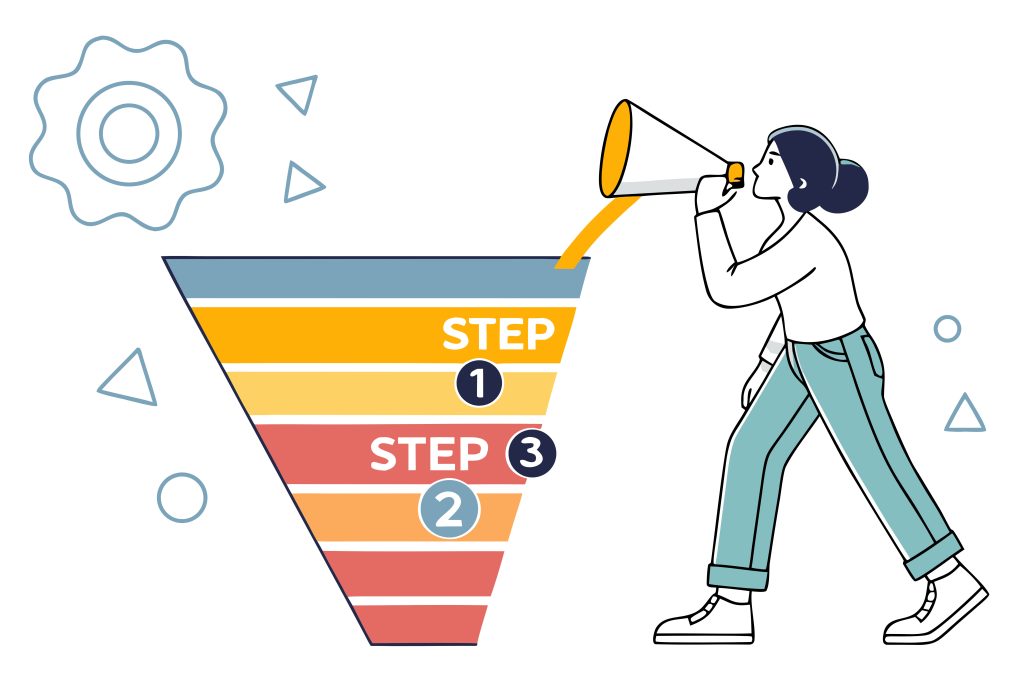From Website Visitor to Paying Client: Building Your First Sales Funnel

Picture this: 1,000 people land on your website this month. Without a system in place, maybe a handful become clients. But with a clear sales funnel, dozens or even hundreds could turn into paying customers.
For many small business owners, the concept of a sales funnel feels abstract. They know they need more leads, but they don’t understand how to guide visitors step-by-step from curiosity to commitment.
Here’s the truth: a structured sales funnel is the missing link between website traffic and steady revenue. In this post, we’ll break down the stages of the funnel, show you where businesses lose potential customers, and explain how tools like automated workflows and CRM pipeline management can turn your website into a true growth engine.
Understanding the Sales Funnel Framework
At its core, it follows four stages: Awareness, Interest, Consideration, and Action, often referred to as the AIDA model.
Think of it as a roadmap. Without one, people wander aimlessly on your website. With one, you guide them toward the destination: becoming a customer.
Why Funnels Matter for Small Businesses
Funnels provide predictability. Instead of guessing how many leads will close each month, you can calculate conversion rates at each stage and forecast revenue. Funnels also improve resource allocation; you’ll know where to focus marketing dollars and where leads are falling through the cracks.
Addressing the “Rigid Funnel” Myth
Some argue funnels are outdated or too rigid. But modern funnels adapt to buyer behavior. They aren’t linear. A prospect might skip from awareness to action if your offer is compelling enough. The funnel isn’t a cage; it’s a framework to help you focus and optimize.
Building the Funnel: Stage by Stage
Stage 1: Awareness – Attracting Visitors
How do people discover you? This stage is about visibility.
- SEO: Blog posts that rank for keywords your clients search.
- Social Media & Paid Ads: Campaigns that put your brand in front of the right eyes.
Example: A local law firm publishes blog content around “business contract tips,” driving qualified traffic directly from Google searches.
When visitors first land on your site, the last thing you want is confusion. A high-converting B2B website design seamlessly guides users from awareness into interest. If you’re curious what makes a B2B site truly effective, think crisp UX, clear messaging, and strategic CTAs. Check out our guide on 5 Essential Best Practices for a High-Converting B2B Website.
Stage 2: Interest – Capturing Attention
Once someone finds you, how do you hold their attention?
- Lead Magnets: Free guides, checklists, or webinars in exchange for an email address.
- Compelling Website Offers: “Get our free tax planning guide” converts browsers into contacts.
Visual Tip: A simple diagram showing: Website → Lead Magnet → Email Capture.
Stage 3: Consideration – Nurturing Prospects
Now they’re on your list. Your job is to build trust.
- Email Nurture Sequences: Educational content that answers questions before they ask.
- Testimonials & Case Studies: Social proof that reduces hesitation.
Data Point: Nurtured leads make 47% larger purchases compared to non-nurtured leads (Marketo).
Stage 4: Action – Converting to Customers
Finally, it’s time to close.
- Strong CTAs: Clear, action-oriented buttons like “Schedule Your Free Consultation.”
- Landing Page Optimization: Clean design, simple form, no distractions.
- Frictionless Checkout or Sign-Up: Don’t make them jump through hoops.
Identifying and Fixing Funnel Leaks
Every funnel leaks; it’s normal. The key is plugging the biggest holes.
Common Drop-Off Points
- Visitors who never opt-in.
- Emails left unopened.
- Weak CTAs that fail to inspire action.
Metrics That Matter
Track conversion rates at every stage. Monitor cost per lead and ROI benchmarks. If you don’t measure, you can’t improve.
How to Fix Leaks
- A/B Test Your CTAs: Sometimes one word makes the difference.
- Re-Engagement Campaigns: Win back cold leads with special offers.
- Remarketing Ads: Remind people who visited your site but didn’t convert.
Example: An eCommerce store recovered 20% of lost sales using abandoned cart emails.
Scaling with Automation and CRM Tools
A sales funnel is powerful, but when managed manually, it can quickly become overwhelming. Tracking leads in spreadsheets, remembering to send follow-ups, and monitoring progress across multiple touchpoints eats up time and leaves plenty of room for human error. That’s why automation and CRM pipeline management aren’t “nice-to-haves”; they’re the backbone of a modern, scalable funnel.
Seeing the Bigger Picture with Pipeline Visibility
A CRM system acts like the dashboard of your business. Instead of guessing where prospects are in their journey, you can see it at a glance: who’s just entered the funnel, who’s actively engaging, and who’s close to signing. This visibility turns abstract numbers into actionable insights, helping your team prioritize the right conversations.
Automating the Heavy Lifting
Automation ensures that no opportunity slips through the cracks. You can set up workflows that trigger actions based on customer behavior:
When someone downloads a free guide, they’re automatically added to a targeted nurture sequence.
If a prospect visits your pricing page, the sales team gets an alert to follow up.
Leads who haven’t responded in weeks can be re-engaged with a pre-scheduled reminder or special offer.
These automations don’t replace personal connection; they free your team to deliver it at the right moments.
Putting It into Practice
Today’s automation isn’t just about simple email sequences; it’s evolved into multi-channel customer journey orchestration. For a deeper look at how modern systems like HighLevel combine CRM, behavior-based triggers, and real-time analytics to fuel business growth, check out our article The Evolution of Marketing Automation: Powering Business Growth in 2025.
Why Continuous Optimization Matters
The best funnels evolve. Buyer behavior shifts, new tools become available, and messaging that worked six months ago might fall flat today. Automation and CRM platforms give you the flexibility to experiment, measure, and refine without overburdening your team.
Final Insight: A funnel is not just a static pipeline; it’s a system. With smart automation and CRM integration, you can keep it running smoothly, scale it as you grow, and ensure every visitor has a guided path from first click to paying client.
The Big Takeaway
A well-designed sales funnel transforms your website from a digital brochure into a client-generating machine. It gives structure to your marketing, predictability to your revenue, and clarity to your team.
Businesses that don’t invest in funnels risk wasted traffic, missed opportunities, and unpredictable growth. Those that do? They build a repeatable system that turns strangers into customers, again and again.
Ready to get started? Map out your funnel today, and explore how CRM automation can help you scale without adding more work to your plate.
About the Author

Kevin Bossons
Senior Digital Strategist
With over 15 years of experience in digital marketing and search engine optimization, Kevin has grown from an SEO contractor to Senior Digital Strategist at WT Digital Agency.